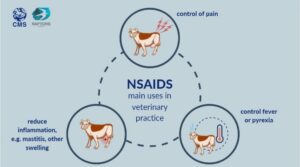VETERINARY NSAIDS AND THE ENVIRONMENTAL SAFETY
Dr. Jyotika is the Dy Manager, Technical & Regulatory at Zenex Animal Health
Dr. Dibyajyoti Kalita is the Head of Technical and Regulatory Affairs at Zenex Animal Health
Email address of corresponding author: jyotikadsangale @zenexah.com
Introduction
Reduction and prevention of pain is an important factor in animal welfare. Non-steroidal anti-inflammatory drugs (NSAIDs) are one of the main therapies used to reduce the inflammation and pain in animals. Due to their analgesic, antipyretic, and anti-inflammatory properties, NSAIDs have many benefits for animals and can lead to improved quality of life. NSAIDs, however, may exerts some adverse effects, can affect the gastro-intestinal, haematopoietic, and renal systems. Gastro-intestinal ulcerations are the most common and serious side effect of NSAIDs, especially in cases of overdose or chronic use.
A wide number of NSAIDs are available in large animal practice. Extensive use of these drugs presents the potential risk for the consumers if food containing drug residues enters the food chain. There is a need for the control of residues and to strictly adhere to the compliance of withholding period of animal produce as specified in the label of the drug. Drug residues in animal tissues also poses a threat for the environment. Certain NSAIDs are found be the cause of reduction of Vulture population in Indian sub-continent.

Fig: NSAIDs use in veterinary practice
Vulture & NSAIDs– Background
Indian vultures are scavenging birds and mostly fed on carcass of animals. It plays an important role in the ecosystem by controlling spread of disease from the dead animal carcass. They fly hundreds of miles in search of carcass and cover wide range of area. Over a period of 10-15 years the vulture population decreased by 97%. There are only 5000 to 15000 birds are present in the whole world therefor the species is classified as critically endangered. Diclofenac was linked with serious reduction in the population of vultures in the Indian sub-continent. Scavenger birds are very susceptible to renal toxicity from certain NSAIDs. Scavenger bird like vultures that fed on the dead carcasses contaminated with such drug residues considered fatal.
Govt of India imposed ban on veterinary use of diclofenac in 2006. Bangladesh, Cambodia, Iran, Nepal, Oman, and Pakistan have fully gazetted restrictions on the production, sale, and use of veterinary Diclofenac. Recently, Union Ministry of Health and Family Welfare, India has imposed a ban on the use, sale, and manufacture of veterinary drugs Ketoprofen and Aceclofenac as they proved toxic for the vultures. Safety review of alternative NSAIDs found meloxicam to be safe for vultures. Recently, another systematic safety study in vultures has confirmed Tolfenamic acid as the safe, after meloxicam. Fortunately, Tolfenamic acid possess more powerful analgesic effect than other conventional NSAIDs.

Fig: Vanishing India’s Vultures Population
Safe NSAIDs for Vultures (Birds):
| DRUG NAME | THREAT/SAFETY | KNOWN EFFECT /RESTRICTIONS |
| Meloxicam | Safe | Tested and shown to be safe for vultures (Swarup D. et.al. 2007) |
| Tolfenamic Acid | Safe | A systematic safety study conducted by the IVRI, BNHS and RSBP has confirmed Tolfenamic acid as the safe NSAID for vultures (Chandramohan et. al. 2022) |
| Caprofen | Toxic at high doses
(Above MLE- Maximum Level of exposure) |
High doses of carprofen (above MLE) based on the concentrations found at the injection site in cattle shown to be toxic level for vulture (Fourie et al. 2012) |
| Aceclofenac | Toxic | Metabolises into diclofenac in cattle to equivalent effect to diclofenac (Galligan et al. 2015, Sharma 2012). Govt of India imposed ban in August 2023 |
| Ketoprofen | Toxic | Trials carried out on Gyps vultures showed toxicity at concentrations found in treated cattle in India (naidoo et al. 2004). Govt of India imposed ban in August 2023, banned in Bangladesh 2021 |
| Diclofenac | Toxic | Confirmed highly toxic in 2003 (Oaks et al. 2003), and banned in India, Bangladesh, Nepal, Combodia, Iran, Oman, Pakistan and Socotra |
Table 1: Safety Data of NSAIDs used in veterinary practice
Tolfenamic Acid – A Vulture Safe NSAID
Tolfenamic Acid, an anthranilic acid derivative is a non-steroid anti-inflammatory drug that belongs to fenamate group. Tolfenamic acid possesses anti-inflammatory, analgesic and antipyretic properties. Research data shows that Tolfenamic acid has higher safety and a wide range of applications in veterinary practice. It is approved in EU and other countries for use in dairy cattle as a NSAID in different disease condition like mastitis and respiratory tract disease. Compared to other drugs of the same kind, Tolfenamic acid exhibits a better effect without any side effects.
Mechanism of Action
Tolfenamic acid inhibits prostaglandin biosynthesis and also exhibits an inhibitory effect on prostaglandin receptors. Tolfenamic acid is based on the primary mechanism of NSAIDs which is inhibition of the COX-1 and COX-2 pathways to inhibit prostaglandin secretion and activity and thus exert anti-inflammatory and analgesic effects. It has a direct antagonistic action on the prostaglandin and tromboxans receptors, causing reduction in synthesis of both substances, the major mediators of the inflammatory processes. Also, several reports indicate that Tolfenamic Acid inhibits the leukotriene B4 (LOX) chemotaxis of polymorphonuclear leukocytes, resulting in even 25% inhibition of chemotaxis. These additional activities of non-specific anti-inflammatory mechanism makes it more potent.
Pharmacokinetics
Tolfenamic acid is distributed in all organs with high concentrations in plasma, gastrointestinal tract, liver, lungs, and kidneys. Tolfenamic acid and its metabolites cross the placenta poorly. Distribution of Tolfenamic acid occurs via the extracellular fluid, achieving plasma-like concentrations in both healthy and inflamed peripheral tissues. It is also found in milk in its active form, mainly associated with curd. Tolfenamic acid undergoes extensive enterohepatic circulation and is found in plasma concentrations for extended periods of time. The elimination half-life is 8 to 15 hours in cattle.
Advantages of Tolfenamic acid in Veterinary Medicine
- Tolfenamic acid is one of the safest & effective NSAID. It is approved for use in food producing animals in the EU and other countries.
- Tolfenamic acid possess stronger efficacy which is comparable to the historically favoured veterinary NSAID – Diclofenac.
- Tolfenamic acid is used in veterinary medicine for its anti-inflammatory, antipyretic and analgesic properties. It is also effective when combined with antibiotics to treat respiratory diseases and mastitis in cattle.
- Analgesic activity of Tolfenamic acid is more powerful than other NSAIDs like meloxicam.
- The mean plasma life of Tolfenamic acid is longer than other commonly used NSAIDs which makes it more prolonged effect. A single intramuscular administration makes it effective for at least 48 hours and can be recommended as single shot therapy.
- Tolfenamic acid has good general tolerability when administered intravenously in cattle. It is well tolerated when administered in pigs and cattle at doses corresponding to 4 times the therapeutic dose.
- Tolfenamic acid can be used in pregnancy and during lactation. However, 24 hours milk withholding period is required.
- Tolfenamic acid has been found to be completely safe in vultures.
Tolfenamic acid in Vultures
For years animals have been treated with NSAIDs to minimize pain and inflammation. But Certain NSAIDs like Diclofenac, Ketoprofen & Aceclofenac are found to cause renal toxicity in birds. Few cases have reported for the death of Gyps vulture in south Asia because of feeding on animal carcass treated with such drugs. A systematic safety review vultures has confirmed Tolfenamic acid as the safe NSAID for vultures, after meloxicam. The study was conducted by the Indian Veterinary Research Institute (IVRI), the Bombay Natural History Society (BNHS) and the Royal Society for the Protection of Birds (RSPB), in total of 38 wild & captive vultures.
Conclusion:
NSAIDs are most widely used therapeutics in veterinary practice due to their multiple benefits. Though wide range of drugs are available in this category, careful selection to be made while using in food producing animals considering their safety, efficacy, and residual effects. Tolfenamic acid has been proven to be effective against several diseases: mastitis, respiratory disorders, arthritis, Musculo-skeletal disorders, among others in cattle, sheep, goat, equine & pigs. Apart from cyclooxygenase inhibition, Tolfenamic acid exerts direct antagonistic action on the prostaglandin, tromboxans receptors and leukotriene B4 (LOX) chemotaxis which makes it more powerful NSAID. The mean plasma life of Tolfenamic acid is longer than other commonly used NSAIDs which makes it more prolonged effect. Tolfenamic acid is the only authorised NSAID with an action of 48 hours and can be recommended as single shot therapy. Clinical investigations of the drug in vultures found to be completely safe. There are no reports of adverse effects on body physiology and no residual hazards in edible soft tissues when used as per recommended dose.


